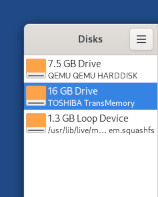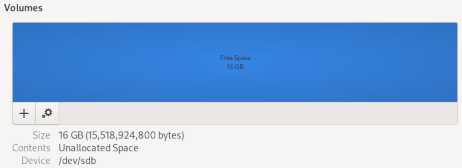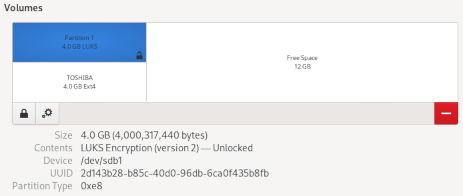Introduzione a LUKS
The simplest way to carry around the documents that you want to use with Tails encrypted is to use the Persistent Storage.
Potete creare altri volumi criptati utilizzando LUKS per criptare, per esempio, un'altra chiavetta USB o un hard disk esterno. LUKS è lo standard per la crittografia dischi in Linux.
L'utilità Disks vi permette di aprire volumi criptati.
Il desktop GNOME ti permette di aprire volumi criptati.
Such encrypted volumes, like the Persistent Storage, are not hidden.
Tali dispositivi cifrati non sono nascosti. Un attaccante in possesso del dispositivo può sapere che all'interno c'è un volume cifrato. Prendete in considerazione che potreste essere ingannati o costretti a fornire la frase d'accesso.
Confronto tra LUKS e VeraCrypt
Potete anche aprire volumi criptatiVeraCrypt all'interno di Tails. VeraCrypt è un tool per la crittografia del discorso per Windows, macOS e Linux. Guardate la nostra documentazione riguardo VeraCrypt.
Ti consigliamo di usare:
VeraCrypt to share encrypted files across different operating systems.
LUKS to encrypt files for Tails and Linux.
| LUKS | VeraCrypt | |
|---|---|---|
| Compatibility | Linux | Windows + macOS + Linux |
| Create new volumes | Yes | Outside of Tails |
| Open and modify existing volumes | Yes | Yes |
| Encrypted partitions (or entire disks)¹ | Yes | Yes |
| Encrypted file containers¹ | Complicated | Easy |
| Plausible deniability² | No | Yes |
| Ease of use | Easier | More complicated |
| Speed | Faster | Slower |
Guardate la differenza tra contenitori di file e partizioni.
Negazione plausibile: In alcuni casi (per esempio con i volumi nascosti VeraCrypt), è impossibile per un avversario provare tecnicamente l'esistente di un volume criptato.
Still, deniable encryption might not protect you if you are forced to reveal the existence of the encrypted volume. See VeraCrypt: Plausible Deniability.
Creare una partizione criptata
Choose Apps ▸ Utilities ▸ Disks to open the Disks utility.
Identificate il vostro dispositivo di immagazzinamento esterno
L'utilità Dischi mostra tutti i dispositivi di memoria sul lato sinistro dello schermo.
Selezionate il dispositivo di memoria esterna che intendete utilizzare.
Un nuovo dispositivo appare nella lista dei dispositivi di memoria. Cliccaci.
Verificate che la descrizione del dispositivo sul lato destro dello schermo corrisponda al vostro dispositivo: la sua marca, le sue dimensioni ecc.
Formatting the device
Click on the
 button in the title bar and choose
Format Disk to erase all the existing partitions on the device.
button in the title bar and choose
Format Disk to erase all the existing partitions on the device.Nella finestra di dialogo Formatta disco:
Se desideri sovrascrivere tutti i dati sul dispositivo, scegli Sovrascrivi i dati esistenti con zeri nel menu Cancella.
Overwriting existing data does not erase all data on flash memories, such as USB sticks and SSDs (Solid-State Drives).
See the limitations of file deletion.
Scegli Compatibile con tutti i sistemi e dispositivi (MBR/DOS) nel menu Partizionamento.
Clicca Formatta.
Nella finestra di conferma assicurati che il dispositivo sia corretto.
Clicca Formatta.
Creare una nuova partizione cifrata
Adesso lo schema delle partizione al centro dello schermo mostra un dispositivo vuoto:
Clicca sul bottone per creare una nuova partizione sul dispositivo.
Configure the various settings of your new partition in the partition creation assistant:
Nella finestra Creare Partizione:
Dimensione Partizione: potete creare una partizione sull'intero dispositivo o solo su una parte di esso.
In the example below, we are creating a partition of 4.0 GB on a device of 8.1 GB.
Nella finestra Formatta disco:
Volume Name
Puoi impostare un nome per la partizione Questo nome rimane invisibile finché non si apre la partizione ma può aiutarti ad identificarla durante l'utilizzo.
Erase
You can choose to overwrite existing data on the partition.
Overwriting existing data does not erase all data on flash memories, such as USB sticks and SSDs (Solid-State Drives).
See the limitations of file deletion.
Type
*Seleziona Cifrato, compatibile con sistemi Linux solo (Ext4) e Partizione protetto da password (LUKS).
Nella finestra Set Password:
Password: Scrivi una frase d'accesso per la partizione cifrata e ripetila per confermare.
We recommend choosing a long passphrase made of 5 to 7 random words. Learn about the maths behind memorizable and secure passphrases.
It is impossible to recover your passphrase if you forget it!
To help you remember your passphrase, you can write it on a piece of paper, store it in your wallet for a few days, and destroy it once you know it well.
Dopo clicca Creare.
La creazione della partizione potrebbe richiedere da pochi secondi ad alcuni minuti. Dopodiché la nuova partizione cifrata apparirà nei volumi sul dispositivo:
Se volete creare un'altra partizione nello spazio libero sul dispositivo, cliccate sullo spazio libero e cliccate nuovamente sul bottone .
Usare la nuova partizione
Puoi aprire questa nuova partizione dalla barra laterale del File browser con il nome che le avete dato.
Aprire una partizione cifrata esistente
Quando si collega un dispositivo che ha una partizione cifrata, Tails offre di aprire automaticamente la partizione.
Inserisci il dispositivo di memoria esterna che ha la partizione cifrata.
A dialog appears, asking for the passphrase to unlock the partition.
Inserite la frase d'accesso della partizione nel prompt della password e cliccate su Sblocca.
If you turn on the option Remember Password, Tails remembers the passphrase of this partition only until you shut down. The passphrase is not stored in your Persistent Storage.
Dopo averla sbloccata, puoi accedere al contenuto della partizione dalla barra laterale del File browser.
Dopo che hai finito di usare la partizione clicca sul bottone ![]() vicino alla partizione nella
barra laterale del File browser per espellere la partizione e bloccare di nuovo correttamente
la cifratura.
vicino alla partizione nella
barra laterale del File browser per espellere la partizione e bloccare di nuovo correttamente
la cifratura.
Aprire volumi cifrati da altri sistemi operativi
E' possibile aprire questi volumi cifrati da altri sistemi operativi; tuttavia, facendolo potresti compromettere la sicurezza fornita da Tails.
Per esempio, l'altro sistema operativo potrebbe creare e salvare provini delle immagini. Oppure, il contenuto dei file potrebbe venire indicizzato dall'altro sistema operativo.
Cambiare la frase d'accesso di una partizione cifrata esistente
Choose Apps ▸ Utilities ▸ Disks to open the Disks utility.
Collega il dispositivo di archiviazione esterno contenente la partizione cifrata per la quale vuoi cambiare la frase d'accesso.
Il dispositivo viene visualizzato nell'elenco dei dispositivi di archiviazione. Cliccaci sopra.
Verificate che la descrizione del dispositivo sul lato destro dello schermo corrisponda al vostro dispositivo: la sua marca, le sue dimensioni ecc...
Cliccate sulla partizione visualizzata nel bottone in basso a destra
 .
.Clicca sul bottone
 e scegli Cambia frase
d'accesso nel menù contestuale.
e scegli Cambia frase
d'accesso nel menù contestuale.




